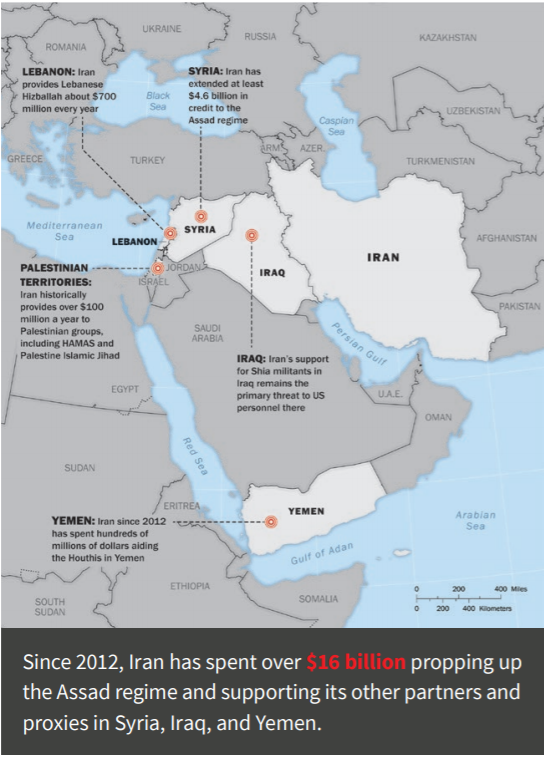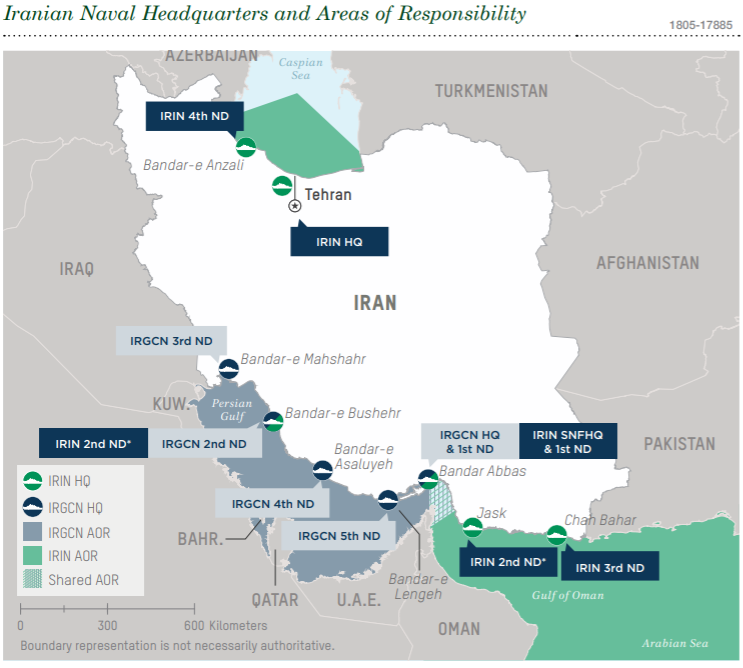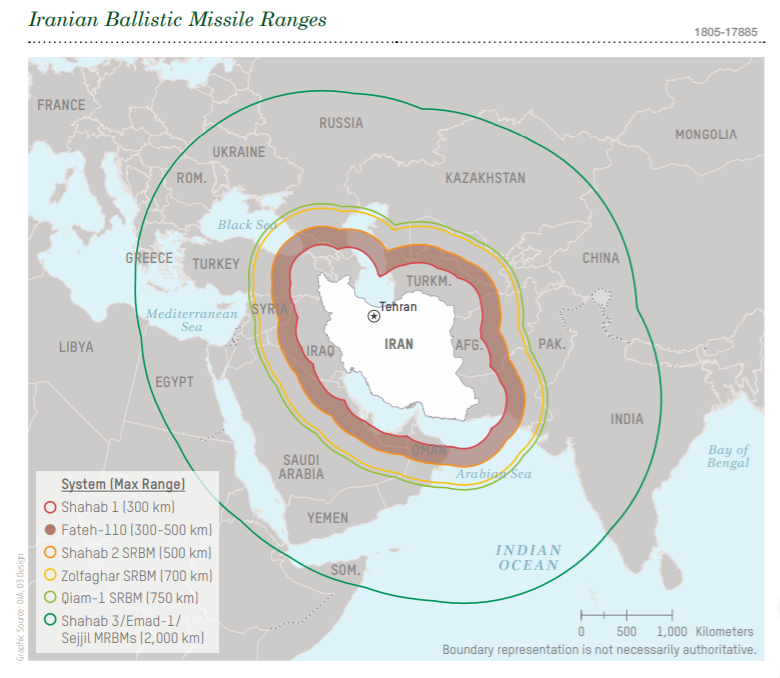By Andrew Hanna
As of January 2020, the United States possessed an overwhelming advantage in conventional military capabilities in the Persian Gulf – dominating in both air and naval power. But Iran’s unconventional capabilities, along with its array of short- and medium-range ballistic missiles, posed a threat to American assets and partner forces.
After the 1979 revolution, Iran formed two separate militaries – conventional forces, or Artesh and the Islamic Revolutionary Guard Corps (IRGC). Each was divided into their own air, sea and ground components. The IRGC, including its paramilitary reservists, was larger and better equipped than Iran’s conventional military. It was also responsible for overseeing Iran’s proxies in the Middle East.
Between May 2019 and January 2020, Iran demonstrated the range and impact of its missile arsenal with attacks on Saudi Arabia and Iraq as well as oil tankers near the Strait of Hormuz. It also shot down a sophisticated U.S. drone. The U.S. responded by sending additional troops and military assets to its partners in the region. Below is an overview of the military capabilities and forces of the U.S. and Iran in and around the Persian Gulf.
Overview of U.S. and Iran military forces in the Persian Gulf:*
|
|
Iran
|
United States
|
Ground |
Artesh Ground Force: IRGC Ground Force: 1,900 Tanks Proxies/Unconventional Forces Iraqi Militias: 75,000-145,000 fighters Houthis: 10,000-30,000 personnel |
60,000 to 80,000 troops in and around the Persian Gulf: 14,000 in Afghanistan |
Air |
Islamic Republic of Iran Air Force: IRGC Aerospace Force: |
Al Udeid Airbase (Qatar): Al Dhafra Air Base (UAE): |
Navy |
Islamic Republic of Iran Navy: 19 Submarines, various classes 7 Corvettes, various classes 13 Fast Attack Craft, Kaman class 40 Patrol Craft, various classes IRGC Navy: 10 Fast Attack Craft, Houdong class 46 Fast Attack Craft of various classes (Chinese, North Korean) Multiple inshore patrol craft outfitted with machine guns and rockets |
Fifth Fleet (Bahrain): One Carrier Strike Group One Aircraft carrier At least one cruiser Destroyer squadron (6-10 destroyers or frigates) 65-70 fighter aircraft Other bases |
Ballistic Missiles/Missile Defense |
Ballistic Missiles Solid propellant SRBMs: Fateh-110, Zolfaghar (300-700 km) Liquid propellant MRBM: Shahab 3, Emad 1 variant (2,000 km) |
Missile Defense Two THAAD batteries in the UAE (purchased by UAE) |
*all estimates based on public reporting and U.S. government unclassified reports
Ground Forces
Iran
Iran’s conventional ground force, or Artesh, is Iran’s first line of defense in the event of a foreign invasion. In January 2020, it had around 350,000 personnel organized into 50 combat brigades. It maintained five regional headquarters, each responsible for the defense of several provinces within Iran. The Artesh’s army aviation division had several hundred attack, transport, and reconnaissance helicopters – including U.S.- platforms purchased prior to the 1979 Islamic revolution.
IRGC ground forces were responsible for operations outside of Iran, while its Basij paramilitary reserve countered internal threats. The IRGC had an estimated 150,000 members, with 450,000 Basij reservists. The IRGC ground forces had 31 provincial corps, with one specific for Tehran. Its units were primarily light infantry and commandos. The IRGC also had three special operations divisions known as the Saberin, or “patient ones.” These units were skilled in “raiding, hostage rescue and heliborne assault,” according to the DIA’s 2019 report on Iran Military Power. Saberin units supported Iranian combat operations in Syria.
The IRGC’s elite Qods Force also had both unconventional and proxy forces to boost its military reach. The Qods Force had roughly 5,000 men, according to U.S. government estimates. They worked with proxies and affiliated militias across the Middle East and South Asia, including Hezbollah in Lebanon, the Houthis in Yemen, and various Shiite militia groups in Iraq and Syria. The State Department estimated Iran provided $16 billion in funding to its various proxies between 2012 and 2018.

Source: U.S. Department of State report, 2018
United States
As of January 2020, the United States had between 60,000 and 80,000 U.S. troops deployed in the Middle East and Afghanistan. The U.S. began increasing its regional presence in May 2019 in response to an increased threat from Iran. By October 2019, the U.S. had added 14,000 additional troops to the 60,000 forces in and around the Persian Gulf. On January 3, 2020, the Pentagon committed another 3,500 troops to the region after killing Qods Force commander Qassem Soleimani. U.S. ground forces were primarily based out of Kuwait and Afghanistan, with additional forces in surrounding countries. the Pentagon added military personnel and assets to Saudi Arabia, Kuwait, Qatar, and the United Arab Emirates during six new troop deployments between and December 2019.

Sources: Congressional Research Service reports on Afghanistan (September 2019); Bahrain (November 2019); Kuwait (December 2019); Oman (October 2019); Qatar (December 2019); Saudi Arabia (November 2019); UAE (November 2019); U.S.-Iran Conflict and Implications for U.S. Policy (January 2020); Washington Post (January 2020)
Air Power
Iran
Iran’s air capabilities were split between its conventional air force and the IRGC Aerospace Force. The Khatemolanbia Air Defense Headquarters coordinated operations between the two services. The conventional air force flew legacy aircraft—from the shah’s era--made by the U.S., Russia and China. As of November 2019, its primary attack aircraft were outdated American F-14 Tomcats. The IRGC Aerospace Force was smaller than the conventional air force and was comprised mainly of Russian aircraft. The IRGC also manufactured and deployed unmanned aerial vehicles (UAVs), to conduct intelligence, surveillance and reconnaissance missions, as well as cross border strikes.
United States
The forward airbase for U.S. Central Command was at al Udeid airbase in Qatar. As of January 2020, there were 10,000 to 13,000 U.S. personnel at the airbase. In 2019, the Trump administration deployed additional F-22 fighters and B-52 bombers to al Udeid in response to escalating tensions with Iran. The U.S. also maintained the Al Dhafra Air Base in Abu Dhabi which hosted around 3,500 U.S. personnel. In May 2019, it deployed B-52 bombers to the al Udeid base, and in October, it deployed the F-35 Lightning II – a next generation stealth fighter jet – to al Dhafra. In January 2020, the U.S. sent six additional B-52s to a military base on the island of Diego Garcia in the Indian Ocean.
Naval Power
Iran
Iran had two independent naval forces: a conventional forces Navy and the IRGC Navy. The conventional navy was responsible for naval security in the Caspian Sea and the Gulf of Oman, while the IRGC Navy had sole responsibility for the Persian Gulf. The two forces shared joint responsibility for the Strait of Hormuz. The conventional navy possessed larger surface combatant ships than the IRGC Navy, many of which date back to the 1960s and 1970s. The IRGC Navy focused instead on asymmetric warfighting within the Persian Gulf. Ten Chinese-built Houdong fast attack craft served as the capital ships of the IRGC Navy, according to a 2017 estimate by the Office of Naval Intelligence. The IRGC Navy also possessed four types of North Korean-built torpedo boats, two of which were submersible. They were supported by small inshore boats outfitted with machine guns or rockets, as well as mine laying craft.

Source: DIA Iran Military Power, 2019
United States
The U.S. Fifth Fleet was headquartered at Bahrain, from which all U.S. naval operations in the Persian Gulf are coordinated. As of January 2020, the base was host to 7,000 U.S. personnel with 18 ships deployed. The U.S. Navy also had basing agreements with Kuwait, the UAE, and Oman. A Carrier Strike Group – the largest operational unit in the United States Navy – is typically deployed in or near the Persian Gulf. One carrier strike group consisted of an aircraft carrier, at least one cruiser, seven to ten destroyers or frigates and 65 to 70 aircraft. In December 2019, USS Harry S. Truman carrier strike group was deployed to replace the USS Abraham Lincoln in the Persian Gulf.
Ballistic Missiles/Missile Defense
Iran
As of January 2020, Iran possessed an array of short- and medium-range missiles. The centerpiece of the Iranian ballistic missile arsenal is the Shahbab-3, a medium-range ballistic missile (MRBM) with a range of 2,000 kilometers. The Emad 1 variant of the Shahab 3 has the same range with near-precision accuracy. Later variants, such as the Emad 2, were expected to have greater range. Iran’s short-range ballistic missiles (SRBMs) were variants on Scud missiles. Iran has transferred these missiles to its proxies; it sent the Qiam 1 SRBM to the Houthis in Yemen.

Source: DIA Iran Military Power, 2019
United States
The United States responded to the Iranian ballistic missile threat by deploying missile defense platforms to its partners in the region. In May 2019, the Pentagon deployed additional Patriot-3 missile defense batteries to the Middle East in response to intelligence reports of an increased short-range ballistic missile threat in the Persian Gulf. The Pentagon sent additional Patriot missile batteries and one Terminal High Altitude Area Defense (THAAD) system after Iran attacked the Abqaiq oil facility in Saudi Arabia. The United Arab Emirates purchased two THAAD systems from the United States in 2011. THAAD is the most advanced missile defense system developed by the United States.
Andrew Hanna is a research assistant at the U.S. Institute of Peace.
Click here for more information on Iran’s asymmetric capabilities.
